
Cuscuta, commonly known as dodder or amarbel, is a genus of over 201 species of yellow, orange, or red parasitic plants. Formerly treated as the only genus in the family Cuscutaceae, it now is accepted as belonging in the morning glory family, Convolvulaceae, on the basis of the work of the Angiosperm Phylogeny Group. The genus is found throughout the temperate and tropical regions of the world, with the greatest species diversity in subtropical and tropical regions; the genus becomes rare in cool temperate climates, with only four species native to northern Europe.

A marsh is - according to ecological definitions - a wetland that is dominated by herbaceous rather than woody plant species. More in general, the word can be used for any low-lying and seasonally waterlogged terrain. In Europe and in agricultural literature low-lying meadows that require draining and embanked polderlands are also referred to as marshes or marshland.

A salt marsh, saltmarsh or salting, also known as a coastal salt marsh or a tidal marsh, is a coastal ecosystem in the upper coastal intertidal zone between land and open saltwater or brackish water that is regularly flooded by the tides. It is dominated by dense stands of salt-tolerant plants such as herbs, grasses, or low shrubs. These plants are terrestrial in origin and are essential to the stability of the salt marsh in trapping and binding sediments. Salt marshes play a large role in the aquatic food web and the delivery of nutrients to coastal waters. They also support terrestrial animals and provide coastal protection.
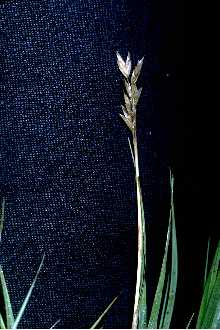
Distichlis spicata is a species of grass known by several common names, including seashore saltgrass, inland saltgrass, and desert saltgrass. This grass is native to the Americas, where it is widespread. It can be found on other continents as well, where it is naturalized. It is extremely salt tolerant.

Cuscuta californica is a species of dodder known by the common names chaparral dodder and California dodder. This is an annual parasitic plant that may resemble fine strands of spaghetti or twine strewn across other species in its habitat. A mature plant of this species may fulfill all of its food and water needs from the host plant, but they rarely kill their host. It is native to western United States and Baja California in Mexico.

Eryngium aristulatum, known by the common names California eryngo and Jepson's button celery, is a species of flowering plant in the family Apiaceae.
Eryngium constancei is a species of flowering plant in the family Apiaceae known by the common name Loch Lomond button celery, or Loch Lomond coyote thistle. It is endemic to California, where it is known from only three occurrences north of the San Francisco Bay Area. One of the populations is at the Loch Lomond Vernal Pool Ecological Reserve at Loch Lomond in Lake County. The plant appears mainly in vernal pools. It is endangered on the state and federal levels.

Juncus acutus, the spiny rush, sharp rush or sharp-pointed rush, is a flowering plant in the monocot family Juncaceae. It is native to the Americas, Northern and Southern Africa, Western and Southern Europe and West Asia, and is found in a variety of wet habitats, such as bogs, fens, meadows, and salt marshes, and along the edges of ponds and lakes.
Euphorbia hooveri is a species of euphorb known by the common names Hoover's sandmat and Hoover's spurge. It is endemic to California, where it grows in the rare vernal pools of the Central Valley. Due to the elimination of most of its habitat, it became a federally listed threatened species in 1997.

Psilocarphus brevissimus is a species of flowering plant in the family Asteraceae known by the common names short woollyheads, woolly marbles, and woolly heads.
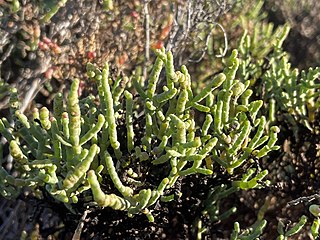
Arthroceras subterminale is a species of flowering plant in the Amaranth family known by the common name Parish's glasswort. It is the only species in the genus Arthroceras. This coastal and inland California native plant is a shrub that is found southerly into northern Mexico, also in both coastal and inland areas, including salt marshes, alkali flats, and other habitats with saline soils.

Sesuvium verrucosum is a species of flowering plant in the family Aizoaceae known by the common names western sea-purslane and verrucose sea-purslane.

Sidalcea calycosa is a species of flowering plant in the mallow family known by the common names annual checkerbloom, checker mallow, and vernal pool checkerbloom.

Spergularia macrotheca is a species of flowering plant in the family Caryophyllaceae known by the common name sticky sandspurry. It is native to western North America from British Columbia to Baja California, where it grows in many types of moist coastal and inland habitat, often in alkaline and saline substrates. It may be found in marshes, alkali flats, beaches, meadows, seeps, and vernal pools. It is a perennial herb producing a narrow stem up to 40 centimeters long with a woody, thickened base and taproot. They may grow erect or prostrate across the ground. It is covered in sticky glandular hairs, especially in the inflorescence. The stems are lined with fleshy linear leaves, sometimes tipped with spines. The leaves are accompanied by triangular stipules up to a centimeter long each. Flowers occur in clusters at the end of the stem as well as in leaf axils. The small flowers have five pointed sepals and five oval white to lavender-pink petals. The fruit is a capsule containing tiny reddish brown, winged seeds.
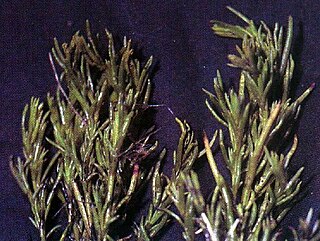
Suaeda calceoliformis is a species of flowering plant in the family Amaranthaceae known by several common names, including Pursh seepweed and horned seablite.
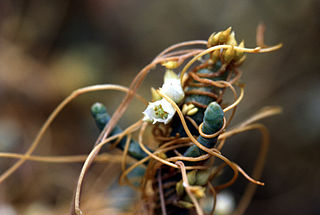
Cuscuta pacifica is a species of dodder. Its common name is goldenthread.
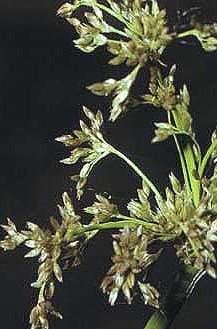
Juncus roemerianus is a species of flowering plant in the rush family known by the common names black rush, needlerush, and black needlerush. It is native to North America, where its main distribution lies along the coastline of the southeastern United States, including the Gulf Coast. It occurs from New Jersey to Texas, with outlying populations in Connecticut, New York, Mexico, and certain Caribbean islands.

Halocnemum strobilaceum is a species of flowering plant in the subfamily Salicornioideae of the family Amaranthaceae. It is native to coastal areas of the Mediterranean Sea and the Red Sea and parts of the Middle East and central Asia, where it grows in coastal and inland salt marshes, alkali flats, and other habitats with saline soils.
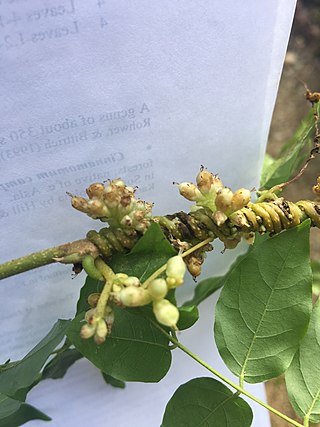
Cuscuta compacta, the compact dodder, is a parasitic plant that specializes on woody plants. This species is distributed across the Eastern and Midwestern USA, Eastern Canada, and Mexico.
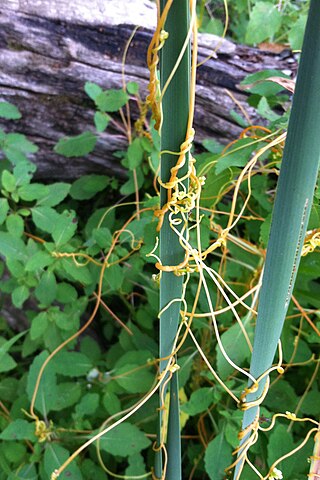
Cuscuta gronovii is a yellow vine that grows as a parasite off other plants. It is a dicot.


















